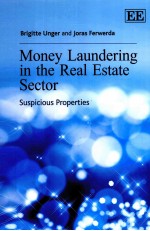

MONEY LAUNDERING IN THE REAL ESTATE SECTORPDF电子书下载
- 电子书积分:9 积分如何计算积分?
- 作 者:BRIGITTE UNGER
- 出 版 社:EDWARD ELGAR
- 出版年份:2011
- ISBN:1849801266
- 页数:175 页
1. Introduction 1
Part One: Economic Approach 5
2. The Real Estate Sector 7
2.1. Size and volume of the real estate sector 8
2.2. The Dutch real estate market 11
2.3. The actors in the real estate market 14
2.4. Some very specific characteristics of the Dutch real estate market: mortgages and taxes 17
2.5. Speculation is an inherent characteristic of the real estate market 17
2.6. The attractiveness of real estate for money laundering 19
3. Forms of Criminal Real Estate Abuse 21
4. Research Method and Indicators 29
4.1. Research method 29
4.2. Indicators 32
5. Operationalizing the Indicators and Data Collection 47
5.1. Data sources 47
5.2. Merging the datasets 50
5.3. Indicators 51
6. Descriptive Data Analysis 63
6.1. The indicators 63
6.2. Comparison of total number of red flags 80
6.3. Comparison between houses and industry 80
7. Evaluation of the Research Method 83
7.1. Correlations 83
7.2. Distribution of red flags per object 85
Part Two: Criminological Analysis&by Luuk Ritzen and Hans Nelen 89
8. Concepts, Methods and Analysis 91
8.1. The concept of conspicuousness and the use of narrative theory 91
8.2. Top-down analysis 92
8.2.1. Top-down phase la: creating case descriptions 92
8.2.2. Top-down phase lb: preparing a data matrix 95
8.2.3. Top-down phase lc: final considerations 101
8.3. Top-down phase 2a: adding 'intelligence' 102
8.3.1. Acquiring fiscal closed source information 102
8.3.2. Acquiring judicial closed source information 102
8.3.3. Top-down phase 2b: finalizing the data matrix 103
8.4. Top-down phase 3: applying the conspicuous label 105
8.5. Bottom-up analysis: gathering 'field intelligence' 107
8.5.1. Sources 107
8.5.2. Comparing the data 109
9. Results of the Criminological Analysis 111
9.1. The selected objects 111
9.2. Results top-down phase 1 112
9.3. Results top-down phase 2 112
9.4. The conspicuous cases 114
9.4.1. Fraud cases 116
9.4.2. Drug cases 118
9.4.3. Irregularities in rent cases 122
9.4.4. Final remarks 124
9.5. Results bottom-up 125
10. Major Findings of the Criminological Analysis 127
10.1. Verifying or falsifying the stated hypotheses 127
10.2. Remarkable findings in the data 128
10.3. Remarkable findings in the top-down analysis 128
10.4. Elaborating on the conspicuous cases 129
Part Three: Statistical and Econometric Analysis 133
11. Linking the Economic and Criminological Parts 135
12. Descriptive Statistics of the Dataset 137
12.1. Frequency analysis 138
12.2. Do more red flags indicate conspicuous cases? 141
12.3. Correlation analysis 141
13. Econometric Analysis 145
13.1. Missing values 145
13.2. Limited dependent variable 146
13.3. Results 146
14. Major Findings 151
15. Suggestions for Further Research 155
16. Summary 159
References 163
Index 171
- 《变压器设计》(德)温格尔(F.Unger)撰;王仲甫译;同济大学工学院电机系编译委员会编辑 1951
- 《水土保持耕作制》(美)安格尔(Unger,P.W.)著 1989
- 《加勒比的安魂曲》(法)布丽吉特·奥贝尔(Brigitte Aubert)著;裘荣庆译 2002
- 《失踪的女孩》(德)布丽吉特·沙尔(Brigitte Schar)著;朱显亮译 2005
- 《黑线》(法)布丽吉特·奥贝尔(Brigitte Aubert)著;郭玉梅译 2002
- 《雪山惨案》(法)布丽吉特·奥贝尔(Brigitte Aubert)著;凌华,志敏译 2002
- 《药草之后蒲公英》布姬特·马尔斯(Brigitte Mars)著;江丰明译 2005
- 《设计管理》Brigitte Borja de Mozota原著;张家瑜译 2005
- 《销售战略》(德)布里吉特·阿姆斯(Brigitte Arms)等著;王草,葛平竹译 2002
- 《IN OUR OWN WORDS:READINGS ON THE PSYCHOLOGY OF WOMEN AND GENDER》MARY CRAWFORD RHODA UNGER 1997
- 《The Elgar Companion to the Chicago School of Economics》Emmett 2010
- 《ELGAR》SIMON MUNDY 2222
- 《EDWARD ELGAR A CREATIVE LIFE》 2222
- 《THE ELGAR COMPANION TO PUBLIC CHOICE SECOND EDITION》MICHAEL REKSULAK LAURA RAZZOLINI WILLIAM F.SHUGHART II 2013
- 《THE CAMBRIDGE COMPANION TO ELGAR》DANIEL M GRIMLEY AND JULIAN BUSHTON 2004
- 《THE ELGAR COMPANION TO MARXIST ECONOMICS》BEN FINE 2012
- 《亚洲的减贫奇迹 成就斐然还是未竟之业?》(以)雅克·西尔伯;万广华编 2017
